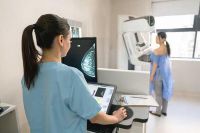Difference between revisions of "About-cancer/screening/screening-tests/zh"
(Created page with "*具有更多的潜在利益大于危害。 (筛查测试的可能危害包括出血或其他物理损伤,不准确的测试结果以及过度诊断,即诊断不会造...") |
(Created page with "===结肠镜检查,乙状结肠镜检查和粪便检查(高灵敏度粪便潜血检查和粪便DNA检查) ===") |
||
| Line 14: | Line 14: | ||
*具有更多的潜在利益大于危害。 (筛查测试的可能危害包括出血或其他物理损伤,不准确的测试结果以及过度诊断,即诊断不会造成问题且不需要治疗的癌症。) | *具有更多的潜在利益大于危害。 (筛查测试的可能危害包括出血或其他物理损伤,不准确的测试结果以及过度诊断,即诊断不会造成问题且不需要治疗的癌症。) | ||
| − | === | + | ===结肠镜检查,乙状结肠镜检查和粪便检查(高灵敏度粪便潜血检查和粪便DNA检查) === |
[[File:5-year-survival-feature-card.jpg|200px|right]] | [[File:5-year-survival-feature-card.jpg|200px|right]] | ||
Revision as of 12:26, 1 November 2019
Contents
- 1 筛检
- 1.1 有效的癌症筛查测试
- 1.2 结肠镜检查,乙状结肠镜检查和粪便检查(高灵敏度粪便潜血检查和粪便DNA检查)
- 1.3 Low-dose helical computed tomography
- 1.4 Mammography
- 1.5 Pap test and human papillomavirus (HPV) testing
- 1.6 Other Screening Tests
- 1.7 Alpha-fetoprotein blood test
- 1.8 Breast MRI
- 1.9 CA-125 test
- 1.10 Clinical breast exams and regular breast self-exams
- 1.11 PSA test
- 1.12 Skin exams
- 1.13 Transvaginal ultrasound
- 1.14 Virtual colonoscopy
- 1.15 More Information
- 1.16 Related Resources
筛检
有效的癌症筛查测试
癌症筛查测试旨在及早发现癌症,在症状产生之前以及何时更容易成功治疗。 有效的筛选测试是:
- 尽早发现癌症
- 减少定期接受筛查的人死于癌症的机会
- 具有更多的潜在利益大于危害。 (筛查测试的可能危害包括出血或其他物理损伤,不准确的测试结果以及过度诊断,即诊断不会造成问题且不需要治疗的癌症。)
结肠镜检查,乙状结肠镜检查和粪便检查(高灵敏度粪便潜血检查和粪便DNA检查)
Several screening tests have been shown to reduce the risk of dying from colorectal cancer. Colonoscopy and sigmoidoscopy not only detect colorectal cancer early but also help prevent the disease in the first place. That's because these tests can find abnormal colon growths (polyps) that can be removed before they become cancer. Expert groups generally recommend that people who are at average risk for colorectal cancer have screening with one of these tests at ages 50 through 75. For more information, see the Tests to Detect Colorectal Cancer and Polyps fact sheet and the PDQ® Colorectal Cancer Screening summary.
Low-dose helical computed tomography
This test to screen for lung cancer has been shown to reduce lung cancer deaths among heavy smokers ages 55 to 74. For more information, see the National Lung Screening Trial page and the PDQ® Lung Cancer Screening summary.
Mammography
This method to screen for breast cancer has been shown to reduce deaths from the disease among women ages 40 to 74, especially those over age 50. For more information, see the Mammograms fact sheet and the PDQ® Breast Cancer Screening summary.
Pap test and human papillomavirus (HPV) testing
These tests, which can be used both alone and in combination, can lead to both early detection and prevention of cervical cancer. They prevent the disease because they allow abnormal cells to be found and treated before they become cancer. Testing is generally recommended to begin at age 21 and to end at age 65 in women who have had adequate prior screening and are not otherwise at high risk for cervical cancer. For more information, see the Pap and HPV Testing fact sheet and the PDQ® Cervical Cancer Screening summary.
Other Screening Tests
Screening tests that have not been shown to be effective may still be offered, especially to people who are known to be at increased risk of cancer.
Alpha-fetoprotein blood test
This test is sometimes used, along with ultrasound of the liver, to try to detect liver cancer early in people at high risk of the disease. For more information, see the PDQ® Liver (Hepatocellular) Cancer Screening summary.
Breast MRI
This imaging test is often used for women who carry a harmful mutation in the BRCA1 gene or the BRCA2 gene; women with these mutations have a high risk of breast cancer, as well as increased risk for other cancers. For more information, see the BRCA Mutations: Cancer Risk and Genetic Testing fact sheet and the PDQ® Breast Cancer Screening summary.
CA-125 test
This blood test, which is often done together with a transvaginal ultrasound, may be used to try to detect ovarian cancer early, especially in women with an increased risk of the disease. Although this test can help to diagnose ovarian cancer in women who have symptoms and can be used to evaluate the recurrence of cancer in women previously diagnosed with the disease, it has not been shown to be an effective ovarian cancer screening test. For more information, see the PDQ® Ovarian Cancer Screening summary.
Clinical breast exams and regular breast self-exams
Routine examination of the breasts by health care providers or by women themselves has not been shown to reduce deaths from breast cancer. However, if a woman or her health care provider notices a lump or other unusual change in the breast, it is important to get it checked out. For more information, see the PDQ® Breast Cancer Screening summary.
PSA test
This blood test, which is often done along with a digital rectal exam, can detect prostate cancer at an early stage. However, expert groups no longer recommend routine PSA testing for most men because many prostate cancers detected with PSA testing are not deadly, and early detection and treatment of PSA-detected cancers has not been shown to reduce the chance of dying from prostate cancer. For more information, see the Prostate-Specific Antigen (PSA) Test fact sheet and the PDQ® Prostate Cancer Screening summary.
Skin exams
Doctors often recommend that people who are at risk for skin cancer examine their skin regularly or have a health care provider do so. Such exams have not been shown to decrease the risk of dying from skin cancer, and they may lead to overtreatment. However, people should be aware of changes in their skin, such as a new mole or a change to an existing mole, and report these to their doctor promptly. For more information, see the Common Moles, Dysplastic Nevi, and Risk of Melanoma fact sheet and the PDQ® Skin Cancer Screening summary.
Transvaginal ultrasound
This imaging test, which can create pictures of a woman’s ovaries and uterus, is sometimes used in women who are at increased risk of ovarian cancer (because they carry a harmful BRCA1 or BRCA2 mutation) or of endometrial cancer (because they have a condition called Lynch syndrome). But it has not been shown to reduce deaths from either cancer. For more information, see the PDQ® Ovarian Cancer Screening summary and the PDQ® Endometrial Cancer Screening summary.
Virtual colonoscopy
This test allows the colon and rectum to be examined from outside the body. Although it has not been shown to reduce deaths from colorectal cancer and may reveal possible problems outside the colon that then need to be investigated further, this test may be recommended if it is the only colorectal cancer screening test a person finds acceptable. For more information, see the Tests to Detect Colorectal Cancer and Polyps fact sheet and the PDQ® Colorectal Cancer Screening summary.
More Information
For complete information about screening tests by cancer type, including tests that are being developed and tests that were used in the past, see the PDQ® Cancer Information Summaries: Screening/Detection (Testing for Cancer)
Related Resources
In an Era of Precision Medicine, Testing New Approaches to Breast Cancer Screening

